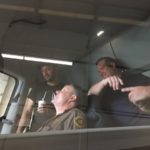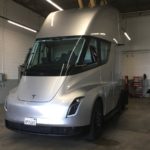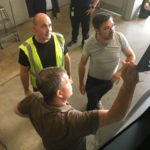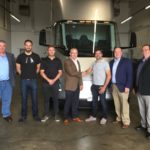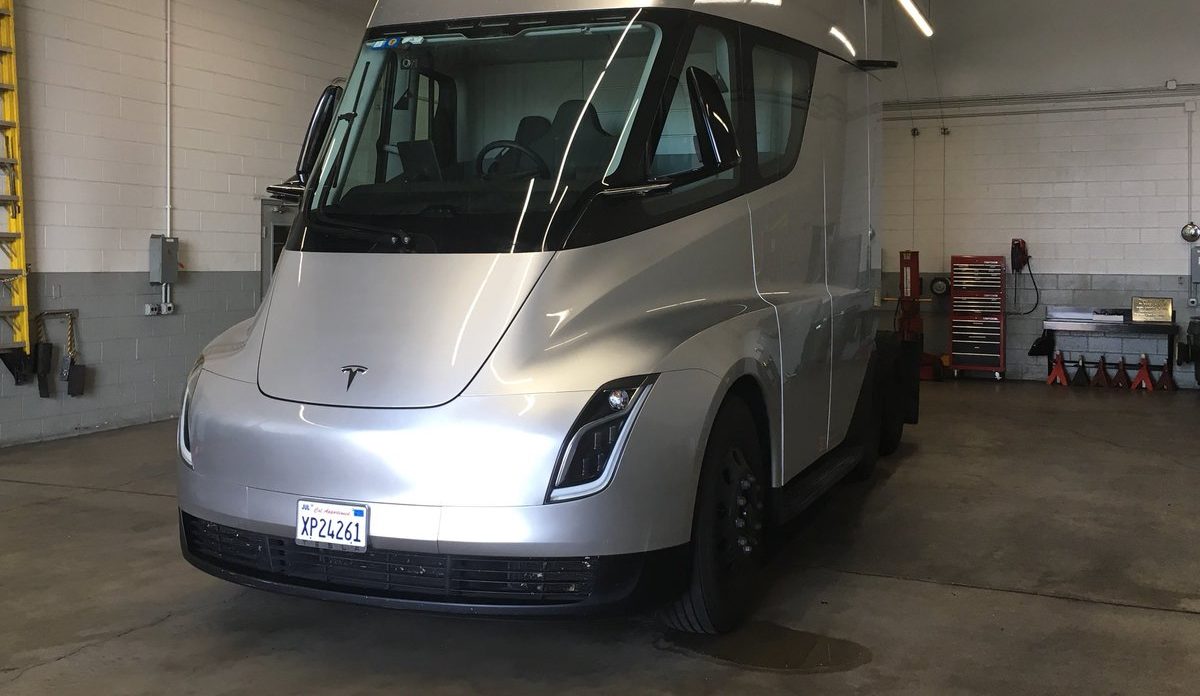
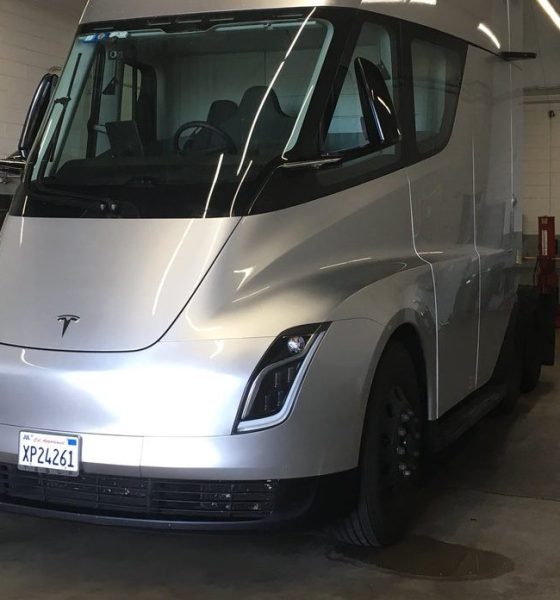
News
Tesla Semi glides over to Addison, IL for hands-on time with UPS employees
Not long after visiting J.B. Hunt’s headquarters in Arkansas and getting spotted at Chicago’s Rolling Meadows Supercharger, the Tesla Semi has been sighted visiting UPS’ hub in Addison, IL. Just like its previous visits to the facilities of other reservation holders, UPS employees were given a chance to get some hands-on experience with the electric long-hauler.
Images and video clips of the Semi’s visit to the UPS Addison hub were uploaded by the parcel service’s official Twitter account in the state, @IllinoisUPSers. Pictures of the event uploaded on Monday show that Tesla’s VP for Truck and Programs Jerome Guillen accompanied the vehicle during its visit as well. One of the videos uploaded by UPS further referenced “rides,” which suggest that Tesla might have given some lucky employees a chance to experience the Semi firsthand.
https://twitter.com/IllinoisUPSers/status/1034163909484335105
https://twitter.com/IllinoisUPSers/status/1034162962611752970
Tesla appears to be starting its push for the Tesla Semi to its reservation holders. As of the Q1 2018 earnings call last May, Tesla has revealed that it has around 2,000 pre-orders for the vehicle. The company has not announced an updated number of reservations for the Semi yet, though Tesla did state during the Q2 2018 earnings call that the electric truck had now been given several improvements since its unveiling last year. Real-world tests of the vehicle are continuing as well, with the all-electric truck being spotted across several states in the US.
While there have been numerous sightings of the Semi since the vehicle was unveiled last November, the recent batch of sightings also indicates that Tesla personnel accompanying and operating the truck are now very willing to answer questions about the vehicle. As noted by Tesla enthusiast @Rec1pr0city on Twitter, the company’s employees answered every question about the Semi and openly allowed photos to be taken while the truck was making a stopover at Rolling Hills Supercharger in Chicago. Coupled with what appears to be an increasing frequency of visits to reservation holders, it appears that Tesla is now starting to increase its push for the electric truck.
- The Tesla Semi at UPS’ Addison Hub. [Credit: IllinoisUPSers/Twitter]
- The Tesla Semi at UPS’ Addison Hub. [Credit: IllinoisUPSers/Twitter]
- The Tesla Semi at UPS’ Addison Hub. [Credit: IllinoisUPSers/Twitter]
- The Tesla Semi at UPS’ Addison Hub. [Credit: IllinoisUPSers/Twitter]
The Tesla Semi at UPS’ Addison, IL hub. [Credit: IllinoisUPSers/Twitter]
The Tesla Semi could very well be the company’s most disruptive vehicle in its lineup. The American trucking industry is vast, responsible for handling the transportation of up to 71% of food, retail goods, construction supplies, as well as other cargo delivered to customers and businesses every day — and it continues to grow by the year. In 2017 alone, the US trucking industry generated $700.3 billion in economic activity, a 3.5% increase compared to the $676.6 billion it made in 2016. This is a market that Tesla could tap into with the Semi.
That said, there remains a number of dedicated doubters who are betting against the Tesla Semi. In a recent statement to Bloomberg, Jon Mills, a spokesman for Cummins Inc., a prominent engine-maker, argued that all-electric trucks like the Semi still have a long way to go before they can be considered as a real competition for diesel trucks. Allen Schaeffer, executive director of the Diesel Technology Forum trade group, is also highly skeptical of the Semi’s quoted specs and operating costs. According to the diesel veteran, Elon Musk’s quotes for the Semi’s estimated $1.26 per mile operating cost have no proof.
The Tesla Semi might look very sleek and futuristic, but it is a vehicle designed from the ground up to be a tough machine. The Semi is equipped with four Model 3-derived electric motors, which give the vehicle instant torque and a 0-60 mph time of 5 seconds without cargo. The long-hauler is also classified as a Class 8 truck, which allows it to haul as much load as conventional diesel trucks. Tesla also listed a range of 300-500 miles per charge for the Semi, though Elon Musk has since noted that the truck’s long-range variant would probably have closer to 600 miles of range per charge.

News
Tesla is not sparing any expense in ensuring the Cybercab is safe
Images shared by the longtime watcher showed 16 Cybercab prototypes parked near Giga Texas’ dedicated crash test facility.

The Tesla Cybercab could very well be the safest taxi on the road when it is released and deployed for public use. This was, at least, hinted at by the intensive safety tests that Tesla seems to be putting the autonomous two-seater through at its Giga Texas crash test facility.
Intensive crash tests
As per recent images from longtime Giga Texas watcher and drone operator Joe Tegtmeyer, Tesla seems to be very busy crash testing Cybercab units. Images shared by the longtime watcher showed 16 Cybercab prototypes parked near Giga Texas’ dedicated crash test facility just before the holidays.
Tegtmeyer’s aerial photos showed the prototypes clustered outside the factory’s testing building. Some uncovered Cybercabs showed notable damage and one even had its airbags engaged. With Cybercab production expected to start in about 130 days, it appears that Tesla is very busy ensuring that its autonomous two-seater ends up becoming the safest taxi on public roads.
Prioritizing safety
With no human driver controls, the Cybercab demands exceptional active and passive safety systems to protect occupants in any scenario. Considering Tesla’s reputation, it is then understandable that the company seems to be sparing no expense in ensuring that the Cybercab is as safe as possible.
Tesla’s focus on safety was recently highlighted when the Cybertruck achieved a Top Safety Pick+ rating from the Insurance Institute for Highway Safety (IIHS). This was a notable victory for the Cybertruck as critics have long claimed that the vehicle will be one of, if not the, most unsafe truck on the road due to its appearance. The vehicle’s Top Safety Pick+ rating, if any, simply proved that Tesla never neglects to make its cars as safe as possible, and that definitely includes the Cybercab.
Elon Musk
Tesla’s Elon Musk gives timeframe for FSD’s release in UAE
Provided that Musk’s timeframe proves accurate, FSD would be able to start saturating the Middle East, starting with the UAE, next year.

Tesla CEO Elon Musk stated on Monday that Full Self-Driving (Supervised) could launch in the United Arab Emirates (UAE) as soon as January 2026.
Provided that Musk’s timeframe proves accurate, FSD would be able to start saturating the Middle East, starting with the UAE, next year.
Musk’s estimate
In a post on X, UAE-based political analyst Ahmed Sharif Al Amiri asked Musk when FSD would arrive in the country, quoting an earlier post where the CEO encouraged users to try out FSD for themselves. Musk responded directly to the analyst’s inquiry.
“Hopefully, next month,” Musk wrote. The exchange attracted a lot of attention, with numerous X users sharing their excitement at the idea of FSD being brought to a new country. FSD (Supervised), after all, would likely allow hands-off highway driving, urban navigation, and parking under driver oversight in traffic-heavy cities such as Dubai and Abu Dhabi.
Musk’s comments about FSD’s arrival in the UAE were posted following his visit to the Middle Eastern country. Over the weekend, images were shared online of Musk meeting with UAE Defense Minister, Deputy Prime Minister, and Dubai Crown Prince HH Sheikh Hamdan bin Mohammed. Musk also posted a supportive message about the country, posting “UAE rocks!” on X.
FSD recognition
FSD has been getting quite a lot of support from foreign media outlets. FSD (Supervised) earned high marks from Germany’s largest car magazine, Auto Bild, during a test in Berlin’s challenging urban environment. The demonstration highlighted the system’s ability to handle dense traffic, construction sites, pedestrian crossings, and narrow streets with smooth, confident decision-making.
Journalist Robin Hornig was particularly struck by FSD’s superior perception and tireless attention, stating: “Tesla FSD Supervised sees more than I do. It doesn’t get distracted and never gets tired. I like to think I’m a good driver, but I can’t match this system’s all-around vision. It’s at its best when both work together: my experience and the Tesla’s constant attention.” Only one intervention was needed when the system misread a route, showcasing its maturity while relying on vision-only sensors and over-the-air learning.
News
Tesla quietly flexes FSD’s reliability amid Waymo blackout in San Francisco
“Tesla Robotaxis were unaffected by the SF power outage,” Musk wrote in his post.

Tesla highlighted its Full Self-Driving (Supervised) system’s robustness this week by sharing dashcam footage of a vehicle in FSD navigating pitch-black San Francisco streets during the city’s widespread power outage.
While Waymo’s robotaxis stalled and caused traffic jams, Tesla’s vision-only approach kept operating seamlessly without remote intervention. Elon Musk amplified the clip, highlighting the contrast between the two systems.
Tesla FSD handles total darkness
The @Tesla_AI account posted a video from a Model Y operating on FSD during San Francisco’s blackout. As could be seen in the video, streetlights, traffic signals, and surrounding illumination were completely out, but the vehicle drove confidently and cautiously, just like a proficient human driver.
Musk reposted the clip, adding context to reports of Waymo vehicles struggling in the same conditions. “Tesla Robotaxis were unaffected by the SF power outage,” Musk wrote in his post.
Musk and the Tesla AI team’s posts highlight the idea that FSD operates a lot like any experienced human driver. Since the system does not rely on a variety of sensors and a complicated symphony of factors, vehicles could technically navigate challenging circumstances as they emerge. This definitely seemed to be the case in San Francisco.
Waymo’s blackout struggles
Waymo faced scrutiny after multiple self-driving Jaguar I-PACE taxis stopped functioning during the blackout, blocking lanes, causing traffic jams, and requiring manual retrieval. Videos shared during the power outage showed fleets of Waymo vehicles just stopping in the middle of the road, seemingly confused about what to do when the lights go out.
In a comment, Waymo stated that its vehicles treat nonfunctional signals as four-way stops, but “the sheer scale of the outage led to instances where vehicles remained stationary longer than usual to confirm the state of the affected intersections. This contributed to traffic friction during the height of the congestion.”
A company spokesperson also shared some thoughts about the incidents. “Yesterday’s power outage was a widespread event that caused gridlock across San Francisco, with non-functioning traffic signals and transit disruptions. While the failure of the utility infrastructure was significant, we are committed to ensuring our technology adjusts to traffic flow during such events,” the Waymo spokesperson stated, adding that it is “focused on rapidly integrating the lessons learned from this event, and are committed to earning and maintaining the trust of the communities we serve every day.”
